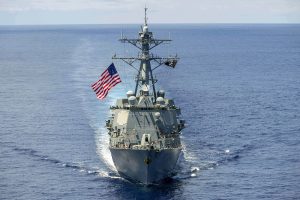Strong calls continue to be made in Washington for the U.S. Navy to increase its freedom of navigation (FON) activities in the South China Sea. This is despite apparent differences of view between the Pentagon and the White House about the wisdom of such action.
The United States has done little in 2015 to ease concerns about whether it knows what it’s doing in the South China Sea. If anything, the rhetoric coming out of the Pentagon, and the U.S. Navy in particular, has become stronger.
While extensive land reclamations in the South China Sea have not helped China’s image, none of its current actions justify deliberate provocations by the United States. It’s not clear just what Washington is protesting in the South China Sea. There are three possibilities, some or all of which may apply.
One explanation may be that the United States is protesting against China’s claim to sovereignty over disputed features. But Washington has repeatedly said that it doesn’t take sides in the island disputes. An authoritative report last year from the Center for Naval Analyses in Washington concluded that “[t]he absence of an unambiguous legal case in any of these disputes reinforces the wisdom of the U.S. policy of not taking a position regarding which country’s sovereignty claim is superior.”
But FON operations against only China’s claims suggest that the United States has taken sides. Washington hotly denies this, but it is how people in the streets of Beijing, Hanoi and Manila see U.S. actions. Resulting surges in nationalism in these capitals are not helpful for resolving the disputes.
A second possibility is that the United States is protesting China’s claim to a territorial sea around built-up, low-tide features in the South China Sea. But only three features fall within this category (Subi, Hughes and Mischief Reefs) and China has not actually made formal claims to any territorial sea from these features. It would be preferable to wait until such claims were made before responding with diplomatic protests rather than ‘rocking the boat’ now.
In any case, it’s a fairly trifling issue on which to risk a dangerous incident between Chinese and American forces.
Finally, the United States may be protesting a general threat by China to FON in the South China Sea. But China has repeatedly denied it poses such a threat. And with so much of China’s own trade passing through the sea it’s nonsensical to suggest that it would. American commentators invariably overstate the value of U.S. trade passing through the South China Sea. They fail to recognize that the vast majority of U.S. trade with East Asia does not go through the area. For their part, Australian politicians also often grossly inflate the amount of foreign trade going through the South China Sea. In the event of some crisis, the trade of other Northeast Asian countries could readily be re-routed away from the South China Sea albeit at some cost in time and distance.
At the heart of the U.S. protests are peculiarly American concerns about FON that relatively few regional countries share. In particular, these include the freedoms to conduct so-called ‘military surveys’ in the exclusive economic zone (EEZ) of another country. Another is the right of a warship to transit a territorial sea without giving prior notification to the coastal state.
It looks as though the United States is trying to turn back the clock on the carefully balanced EEZ regime in United Nations Convention on the Law of the Sea. American commentaries regularly fail to acknowledge that navigational freedoms are not absolute in another country’s EEZ. Military activities in the EEZ should only be conducted with ‘due regard’ to the rights and duties of the coastal state. Much of what the United States calls military surveys really constitutes marine scientific research, which is under the jurisdiction of the coastal state.
A group of Chinese warships recently transited through the U.S. territorial sea around the Aleutian Islands. This led to claims from the United States that China, by not seeking permission to do so, had gone against its own policies of area denial. But China’s conception of FON is different from what the United States is contemplating in the South China Sea. Whereas sending ships patrolling into another country’s territorial sea specifically to demonstrate a right of passage could be a breach of innocent passage, the Chinese ships were on a direct passage.
US commentators also express concerns that China intends to use various facilities it has built in the South China Sea, such as airstrips, for military purposes. But this is another myth. These features have no real utility as military ‘bases’ in view of their vulnerability and the difficulties of their re-supply.
The United States frequently condemns China for ‘militarizing’ the South China Sea. But increased American naval activity in the region and the threatened FON operations constitute greater militarization. The United States is in conflict with China on all fronts – economic, political, strategic and military.
As a middle-power and U.S. ally with close ties to the region, Australia also needs to be cautious in getting too involved in these bilateral tensions. Its best response at this time is to maintain the established pattern of Operation Gateway surveillance flights in the area. And it should be prepared to make a diplomatic protest should China make some formal claim with which Australia does not agree.
Sam Bateman is an adviser to the Maritime Security Program at the S. Rajaratnam School of International Studies (RSIS), Nanyang Technological University. This article was originally published over at East Asia Forum here and is republished with kind permission.

































